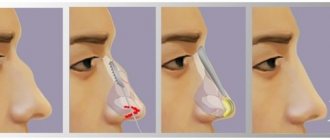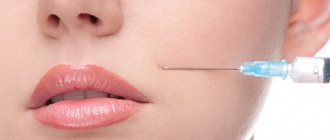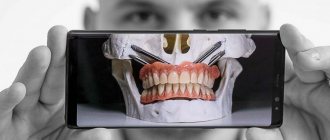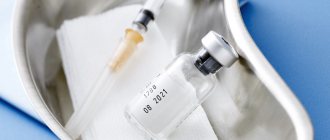Surgical nose correction is a common operation that has made many women happy and confident. There are two methods of influence - open and closed access, but not everyone knows what their features are. We invite you to familiarize yourself with open and closed rhinoplasty and the difference between the procedures.
Open rhinoplasty of the nose
The open type of rhinoplasty is considered a classic option; it has been practiced for many years. The procedure allows the doctor to have visual contact with the site of manipulation. A small incision is made on the columella, and if necessary, it is also made along the wings of the nose. Next, the epithelium is separated from soft, cartilage and bone tissues with special scissors. Using a hook, the skin is pushed upward, and then the operation begins.
This method is familiar to every professional plastic surgeon. It allows you to perform complex operations in the nose area, correct severe asymmetry or completely restore the shape of the respiratory organ after severe injuries or illnesses, and helps get rid of a nasal hump. The same technique is also chosen in cases where revision rhinoplasty is performed.
Indications for open rhinoplasty
Open nose correction is addressed when:
- desire to shorten or reduce a long, wide nose;
- the need to reduce the nostrils;
- pointed, thickened tip of the respiratory organ;
- the presence of deformations of the respiratory organ resulting from injury;
- desire to eliminate the hump;
- congenital pathologies of the respiratory organ;
- low dorsum or saddle nose configuration;
- snub nose.
Also, an open type of rhinoplasty is used by a specialist if the patient has a deviated nasal septum, and this leads to breath retention.
How is the operation performed?
Closed rhinoplasty includes several stages:
- Skin incisions. On both sides, marks are applied to the skin of the nasal vestibule, which correspond to the projection of the tip, for more precise application of the incision. The incision line should be at least 6 mm from the caudal portion of the lateral crus of the greater cartilage to provide adequate support. Then, tweezers and blunt scissors are used to secure the skin over the tip of the nose. Part of the lateral crus is removed. With a drooping tip of the nose and a “hanging” columella, the incision is continued into the transfection one (between the head section of the medial crus of the lateral cartilages and the caudal section of the quadrangular cartilage). To raise the upper lip, the spine of the upper jaw is removed.
- Reducing the length of the nasal septum.
- Exposure of the nasal bridge and removal of the osteochondral hump. With closed rhinoplasty, the osteochondral hump is removed by reducing the height of the nasal bridge. Before resection of the hump, the mucous membrane is mobilized. Then the upper lateral cartilage is partially removed, and if necessary, a lateral osteotomy is performed, which is the next step.
- Lateral dissection of the patient's nasal bone.
- Formation of the tip and wings of the nose. Reducing the size of the tip of the nose is done by weakening the supporting structures. The supporting structures of the nose are scored. If the incisions are applied far from each other, then the nostrils will appear wide and then it is necessary to suture the medial legs of the upper lateral cartilages or use an autograft. The use of an autograft allows you to increase the size of the tip of the nose and ensure its rotation.
- Placement of mattress sutures on the incisions.
- Bandage. Applying a plaster bandage on top of which is a gauze bandage. Intravenous dexamethasone to reduce swelling. According to indications, nasal tamponade is performed.
Closed rhinoplasty
Closed rhinoplasty has also been known for many years, but is still a relatively “young” procedure. It is also called endonasalplasty. Incisions are made on the inside of the nostrils. The entire operation is performed through these small access points.
This type of manipulation is more complex and even comparable to jewelry work, since the experience and qualifications of the doctor are extremely important here.
The surgeon must literally feel the anatomy of the patient's nose to achieve the desired result.
Note that this technique is not applicable to complex operations, since it clearly constrains the doctor with limited visual and tactile access to the site of influence. Remember that even if endoscopic correction is prescribed, it is not a fact that the doctor will ultimately perform it.
During the procedure, the plastic surgeon may change the technique if it turns out that there are factors that influence the outcome of the procedure - for example, structural features of the nose, anatomical individual factors, thin or thick skin on the respiratory organ, and so on.
If a closed correction was agreed upon, and upon awakening from anesthesia it turns out that an open one was made, do not rush to attack the doctor. Perhaps the characteristics of your body played a big role.
Indications for closed type
Closed rhinoplasty is performed for aesthetic reasons. The operation helps to cope with the narrowing of the nasal passages (or their enlargement), and eliminate the curvature of the nasal septum. The procedure is actively used for hypertrophy of the conchae of the respiratory organ.
Most often, closed rhinoplasty is chosen by women who are not satisfied with the way their nose looks. If the harmony of the face is disturbed, it is worth turning to just such a procedure.
Preparation
Rhinoplasty is considered a serious intervention. The procedure requires thorough preparation. The surgeon conducts a consultation conversation, which helps to ensure that the manipulation is possible. The doctor examines the medical history and sends for diagnostic tests.
It is important to identify all factors that can affect the course of surgery, the result, and the patient’s health status. Mandatory:
- general blood test;
- identification of biochemical indicators;
- analysis for HIV, hepatitis;
- ECG;
- fluorographic examination;
- urine tests.
The doctor additionally sends the patient to an otolaryngologist or dentist. In some cases, opinions of other specialists may be required. It is imperative to clarify the possibility of anesthesia.
To prepare for surgery, a week before the intervention you must avoid:
- blood thinning drugs;
- smoking, alcoholic beverages;
- prolonged exposure to direct sunlight, visiting a solarium.
It is advisable to eat right, exclude fatty, spicy, salty foods from the menu. The patient is recommended to come for the procedure on an empty stomach: do not eat for 8–12 hours. There must be no health complaints. On the day of surgery, no makeup is applied; false eyelashes and lenses are excluded.
Difference in procedures
Open and closed rhinoplasty have the same goal, but they have a huge difference when performed. In particular, if the doctor sees the possibility of performing endonasal plastic surgery, he will make a choice in the direction of this technique. This is explained by the fact that closed rhinoplasty has its advantages and features compared to open rhinoplasty. Let's look at the table to see how closed and open rhinoplasty differ.
| Open rhinoplasty | Closed rhinoplasty |
| Allows you to perform complex operations, use large implants, and carry out complete reconstruction of the nose. | Allows you to perform an operation to straighten the nasal septum, change the shape and length of the olfactory organ. |
| Severely injures blood vessels, causing significant bruising and swelling in the nose, cheeks and eyes. | Hematomas and swelling are not as pronounced, since the vessels are injured much less. |
| Long recovery period. | Rehabilitation takes less time. |
| The final result is visible by about 1.5 years. | The result can be assessed within a year. |
| It provides excellent visual access, and therefore even an inexperienced surgeon can cope with this type of operation. | Limited visual access for the surgeon. Some experience and a sense of the structure of the nose are required. |
| Applicable in cases where closed rhinoplasty did not help. | Not available for certain anatomical conditions. |
| This is done during re-operation. | It cannot be performed during repeated surgery to correct defects. |
| Greater risk of complications. | Less risk of tip ischemia and scar deformation. |
| The seams are on the outside. | The seams are on the inside of the nose and are not visually visible. |
| The operation takes longer. | Less time for surgery. |
As can be seen from the table, each type of operation has its own advantages and disadvantages. We still recommend that you discuss with your doctor which type of correction is best applied in your particular case. Only a qualified specialist will select the appropriate type of exposure based on your medical history and test results.
Diet before surgery
Just a couple of decades ago, before surgery, the patient could not eat solid food for 18-12 hours. Today, doctors have come to the conclusion that this prohibition has been reduced to 6 hours, and coffee and tea can only be drunk 2-3 hours before surgery.
Such recommendations are a necessary measure to avoid the reflux of stomach contents into the lungs. During general anesthesia, all muscles are completely relaxed, and the intestinal, gastric and esophageal sphincters do not work enough. The worst complication of general anesthesia is pneumonia.
Stories from our readers
Fixed my nose shape at home! It's been half a year since I forgot what a hump of the nose is. Although it is generally accepted in society that appearance is not the most important thing for a man, I really didn’t like my nose. In addition, I also work in a field where appearance matters, I work as a wedding host.
Oh, how many consultations I attended - all the doctors quoted exorbitant prices and talked about long rehabilitation, but for me this is in no way suitable because weddings happen all the time, especially during the season. One day I had an appointment with Dr. E. A. Pavlov.
He told me that in my case it is quite possible to do without surgery, it is enough to wear a special corrector every day. Here is an article in which he describes this method in detail. I obediently wore the concealer every day for several months and was amazed at the results, judge for yourself. In the end, I’m very glad that I was able to get by with “little blood”
If you have the same problems with finances or don’t want to go under the knife, then I recommend reading this article
Cost of open and closed rhinoplasty
We will separately discuss the cost of manipulations. It depends on what type of procedure is performed, how complex the operation is, as well as on the specific clinic and the doctor’s qualifications. The price is also affected by the range of medical services provided: hospital, type of anesthesia, medications, and so on. Sometimes there may be an additional cost for testing. Therefore, the cost may vary:
- Open rhinoplasty – from 40 thousand rubles.
- Closed rhinoplasty – from 30 thousand rubles.
- Repeated rhinoplasty – from 140 thousand rubles.
As you can see, open and closed rhinoplasty cost differently, so you and your doctor will have to make the choice. Please note that the prices we indicated are from the area of commercial clinics. Government services are much cheaper, but you will also have to be responsible for the results.
Remember that good plastic surgeons in public hospitals are extremely rare.
Please note that if you decide to have a nose correction, you will need to sign a document that will indicate not only the payment, but also the range of services provided. Read it carefully, because it is a guarantee and guarantee of good results and safety for your health.
Features of the operation
Closed rhinoplasty is a method in which access to the internal tissues of the nose opens only after the plastic surgeon makes a transfection and sometimes transcartilaginous incision.
Since in the closed form the incisions are made only inside the nostrils, the nasal cavity does not open completely.
This creates certain difficulties for the specialist’s work.
If it is necessary to eliminate defects in cartilage tissue, the doctor can make a subchondral or intercartilaginous incision, which will make his work easier by increasing the viewing angle.
Due to the fact that the soft tissues of the nasal cavity are not mobile enough, the result can lead to the fact that the cartilages are not fixed symmetrically. It depends on the experience of the surgeon.
After the specialist eliminates all defects, special sutures (mattress) are applied. This method allows you to reduce the risks of inflammation, suppuration and prevent the accumulation of fluids during the healing period of sutures.
A plaster tape is applied to the nose to fix the position of the tissues.
Throughout the entire correction, the person is under anesthesia. This eliminates the possibility of them feeling pain.
For several hours after the operating room, the person will still be under anesthesia. The rehabilitation period begins the very next day.
Read whether it is possible to enlarge your breasts during pregnancy.
How is silicone breast augmentation performed? Click to find out.
What is the difference between closed rhinoplasty and open rhinoplasty in rehabilitation?
Open rhinoplasty always has a long recovery period compared to the closed type of surgery. After open plastic surgery the following is noted:
- the appearance of scars that can spoil the entire result; with the professionalism of a specialist, the scarring will be insignificant, it can be removed by laser resurfacing;
- puffiness, swelling and cyanosis are observed within 1-2 weeks after open plastic surgery of the respiratory organ;
- the formation of hematomas, they are formed as a result of injury to the vessels, due to manipulations performed by the surgeon during the operation.
After a closed type of rhinoplasty, the rehabilitation period is much faster. Patients will only be given plaster casts, which need to be worn for as long as the surgeon prescribes. Hematomas and swelling will be minor and will disappear after a few days.
Both after open and closed rhinoplasty, you need to follow a few tips during the rehabilitation period:
- Do not blow your nose for 6 weeks;
- visiting swimming pools, baths and saunas is not allowed;
- you cannot lift heavy objects or go to the gym;
- Smoking and drinking alcoholic beverages is not allowed.
The consumption of certain foods may also be limited; the plastic surgeon will discuss this separately.
↑ first stage of rehabilitation – 10-12 days after surgery
The nose may bleed slightly for several days. Unpleasant dry crusts form inside. During this period, it is recommended to rinse your sinuses with salt water. Breathing is somewhat difficult due to swelling. Many patients report tearing and sore throat for 2-3 days.
| Igor Mrochko: In addition, the immobilizing bandage on the face also causes certain inconvenience. Nowadays, plaster is used less and less to fix the nose after surgery, since it has many disadvantages - you cannot predict the quality of its hardening, it is fragile, and crumbles easily. With a minimal amount of correction, you can fix the tissue with metal clips, but they are not very reliable, so I personally prefer to use artificial fiberglass materials. They are lightweight, hold their shape well and cause minimal discomfort to the patient. After 10 days, this bandage is easily removed. After this, you will finally be able to see your new nose, although it will still be distorted by swelling and far from its final shape. |
Recommendations and limitations at the initial stage of rehabilitation after open rhinoplasty:
- Take medications prescribed by your doctor - anti-inflammatory, painkillers, antibiotics.
- No activity, no sports! Do not lift anything heavy, do not make sudden movements with your head.
- No alcohol - it thins the blood, causes swelling and interferes with tissue regeneration. You will have to give up too hot or spicy foods and drinks.
- Sleep only on your back - you can put pillows on the sides so as not to roll over in your sleep.
- If you wear glasses, you will have to temporarily switch to contact lenses: even light frames put pressure on the bridge of the nose and can deform a non-healed nose.
- Avoid swimming in public places - ponds, swimming pools - due to the risk of infection.
- You can wash your head, but not by tilting it down, but on the contrary, by slightly tilting it back, like in a hairdresser.
- With the doctor's permission, you can use Traumeel S and Lyoton gels to speed up the resorption of hematomas.
| Igor Mrochko: I also advise you not to forget about using nasal moisturizers containing regular sea water. After surgery, the mucous membrane becomes dry and crusts form, which impairs nasal breathing and can cause increased bleeding. Regular rinsing with salt water will maintain the necessary level of moisture, soften and cleanse the mucous membrane, and make breathing easier. |
The first stage of rehabilitation is considered the most important and all doctor’s recommendations must be followed strictly! In this case, there should be no problems with healing and the nose will turn out exactly the way you originally imagined it.
Answers to popular questions from patients
Is there a difference between contraindications for closed and open rhinoplasty?
The list of contraindications for rhinoplasty is determined together with a specialist. In most cases, both open and closed types of plastic surgery have the same contraindications. It is better to consult a doctor about this in person.
Is it possible to perform a closed type of rhinoplasty under local anesthesia?
This depends on the specific situation and the level of change required. If minor correction is necessary, local anesthesia is allowed. Complete rhinoplasty requires only general anesthesia.
Opinions of plastic surgeons about open and closed rhinoplasty
Aleksanyan T. A.
Candidate of Medical Sciences, founder of the Art Plastic clinic:
I perform all surgical interventions related to nose correction exclusively using closed access. It is a myth that it is only suitable for mild cases. This method is used in our clinic even if it is necessary to perform repeated surgery. Despite the fact that closed access requires the highest professionalism and skill, we only use it. As a beginner specialist, I only performed open rhinoplasty, but when I switched to closed rhinoplasty, I realized that this was the best solution. Patients can also experience a number of benefits, including the absence of scars and minimizing the recovery period.
Kosinets V. A.
Doctor med. Sci., leading specialist in plastic surgery at GEMC:
The use of open access is relevant when performing reconstructive manipulations, when viewing all areas of the respiratory organ is indispensable. In other cases, I don't use it. Although closed rhinoplasty is a complex method, it guarantees the absence of incisions in the nose area, as well as quick rehabilitation after manipulation. But there are surgeons who find it easier to work with an open approach, and there is nothing wrong with that.
Grigoryants V. S.
Leading surgeon at the Arbat Aesthetic medical institution:
Many patients believe that the difference between open and closed rhinoplasty is only the presence of a scar. But that's not true. Personally, I prefer the open type of exposure, since this is the only way I can fully control the procedure. Open plastic surgery allows me to predict the final result, while with closed access it is much more difficult to do.
Abrahamyan S. M.
Leading specialist at the Frau Clinic in the field of plastic and maxillofacial surgery:
In almost 85% of my nose correction surgeries, I use a closed approach. This allows me to perform all the required manipulations without injuring the tissue. Thanks to this approach, it is possible to significantly facilitate the recovery period, as well as predict the result of the manipulations performed.
Kudinova E. S.
Maxillofacial surgeon, Candidate of Medical Sciences:
I would advise novice plastic surgeons to use the open approach. But for patients, I would recommend closed rhinoplasty. Experienced specialists will be able to provide high-quality results and perform manipulations, taking into account the slightest anatomical features of the structure of the respiratory organ.









